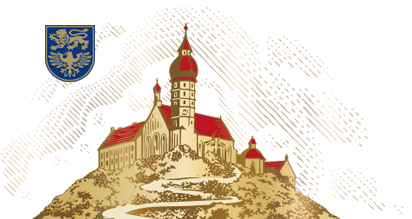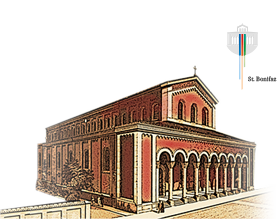- Product range
- History
- Raw materials & brewing process
- Distribution & sales
- Guided Tours
- EMAS environmental certification
- Beer glossary
- Andechs Beer in US
Upheaval and change 1803-1850
After the monastery was dissolved in 1803, the monastery buildings and part of the land first passed through multiple private hands until King Ludwig I was to acquire the entire complex in 1846 as an estate for the planned St. Boniface Benedictine Abbey in Munich for 65,000 gulden.
This included the brewhouse with inventory, which is specifically mentioned in the purchase contract of 11 March 1846. By order of the king, Andechs was first managed by the Metten Benedictines until responsibility was gradually passed to the new abbey after the founding of St. Boniface on 24 November 1850. The existing lease agreements for the brewhouse and operations were supposed to be maintained, but were soon replaced on 1 July 1846. Ludwig I provided another 11,400 gulden for this purpose. Abbot Gregor Scherr von Metten lamented the poor profitability of the agricultural operations and brewery, and urged to take over management with the monastery’s own personnel.
Help from the Benedictines of the Metten Abbey
That same year, the Metten Abbey began recording the establishment’s history. These records were carried on by Father Magnus Sattler starting in 1858, serving as a priceless source of information about events and developments during these years. On 17 September 1846, for example, Father Rupert Mittermüller from Metten writes: “Regarding the estate’s temporal affairs, the very long delay in the arrival of a master brewer resulted in some difficulties and disadvantages. The summer beer, which was purchased from the lessee, ran out towards the end of August and the two innkeepers (in Andechs and Erling) were not happy about this, because they could not obtain more from anywhere. They had just requested from estate management what was incumbent on the new lessee, namely to ensure the supply of beer until Michaelmas. Furthermore, the amount of beer tax to the innkeepers to date first had to be corrected by them, which has not been done as of today (September 17th). The innkeepers are rather overbearing in general. They are demanding the closing of the monastery’s bar! Brewing could probably have started at the beginning of November, but master brewer Geltfinger did not arrive until September 3rd and first had to prepare and rearrange the brewery (cooling, mash tun, cellar, ovens, barley, hops), at the expense of several hundred gulden.”
So the transition was not all that easy. But a short time later in December of 1846, Mittermüller wrote: “The brewery with its beer is already enjoying a good reputation, which has attracted a new innkeeper (in Aschering) and some important customers (Pastor of Perchting, Starnberg office staff). But since the yield from the harvest on the neglected estate was low (112 to 120 bushels of barley), considerable purchases are required to brew at least 1800 to 2000 pails of summer beer. A new loan arranged by the Abbot of Metten in the amount of 1000 fl. was therefore required.” The monastery brewery depended on secular master brewers until 1846. However, a successor from within the monastery community soon came forward. Then the first from the monastery ’s ranks was Brother Ämilian Haltenberger.




